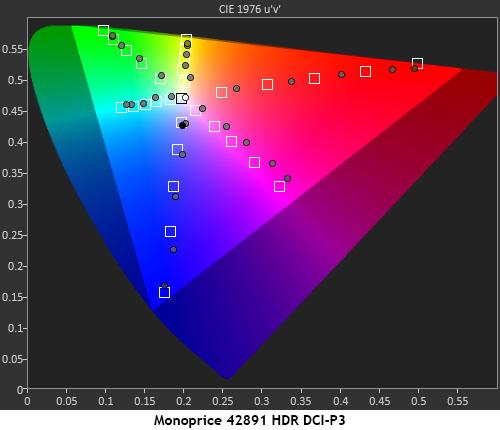Why you can trust Tom's Hardware
Our HDR benchmarking uses Portrait Displays’ Calman software. To learn about our HDR testing, see our breakdown of how we test PC monitors.
Most budget HDR monitors make you switch modes manually for the two signal formats. The Zero-G 42891 will do this automatically in its Auto Detect mode, a nice touch. HDR10 content will display correctly with the appropriate luminance curve and color gamut.
HDR Brightness and Contrast



The Zero-G 42891 manages a tad more brightness in HDR mode with over 342 nits peak available. The other monitors achieve DisplayHDR 400 certification. In most cases, brighter is better but the key factor to good HDR is the black level and overall contrast ratio.
The Zero-G 42891 has a low black level but without dynamic contrast in operation, its HDR contrast ratio is a tad lower than SDR. But that is still better than what the BenQ or Corsair screens can produce. While the Monoprice’s picture isn’t all that different in HDR mode, it is still deeper and more dimensional than the Corsair’s uncompensated image.
Grayscale, EOTF and Color


With no image adjustments available in the Zero-G 42891’s HDR mode, the users will have to settle for a somewhat warm image. If I had to choose an error, it would be red because it won’t flatten the picture like green or blue tints. Most earth tones maintain a natural look with accurate flesh tones.
The error is less pronounced in the darkest and lightest areas. The luminance curve tracks a little dark until the tone-map transition point at 60% brightness. That helps shadows and mid-tones look more contrasty, but some of the darkest details might be hard to see.
The HDR color gamut is generally over-saturated in red and close to target for blue and green. Only magenta shows slight hue errors. The other secondaries are in line. HDR color in practice is warm and lush with a bolder look than the same content in SDR mode. In games like Doom Eternal, there is some benefit to HDR. But in games with a more varied palette like Call of Duty WWII, the SDR and HDR images look about the same.
Get Tom's Hardware's best news and in-depth reviews, straight to your inbox.

Christian Eberle is a Contributing Editor for Tom's Hardware US. He's a veteran reviewer of A/V equipment, specializing in monitors. Christian began his obsession with tech when he built his first PC in 1991, a 286 running DOS 3.0 at a blazing 12MHz. In 2006, he undertook training from the Imaging Science Foundation in video calibration and testing and thus started a passion for precise imaging that persists to this day. He is also a professional musician with a degree from the New England Conservatory as a classical bassoonist which he used to good effect as a performer with the West Point Army Band from 1987 to 2013. He enjoys watching movies and listening to high-end audio in his custom-built home theater and can be seen riding trails near his home on a race-ready ICE VTX recumbent trike. Christian enjoys the endless summer in Florida where he lives with his wife and Chihuahua and plays with orchestras around the state.
-
Gorlash This is very frustrating... I have a 30" 2560x1600 monitor (HP ZR30w), which I really love... it has been my treasured gaming machine for over a decade now... the only drawback, is that it doesn't have any of the modern bling - >60hz, adaptive sync, other fancy stuff...Reply
I would love to look at a new monitor with newer tech... but I'm still holding out for 16:10 aspect ratio... maybe I will just die here with the other old farts...